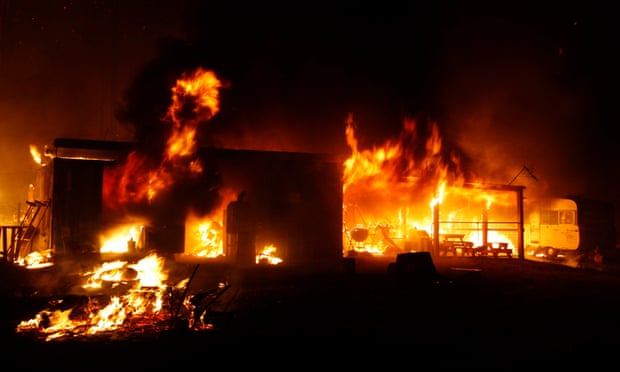Australia has a “massive adaptive program” ahead to prepare for future protracted bushfires and subsequent air pollution, a professor of pyrogeography and fire science has warned, urging politicians to “tone down the ideology and start solving the problem using the skills Australians have”.
David Bowman, the director of the Fire Centre at the University of Tasmania’s school of natural sciences, said it was too late to call for action to prevent climate change and that people affected by smoke inhalation from fires should demand action to adapt to it, such as retrofitting houses to make them heat and smoke-proof.
“It’s a transformative time socially, and politicians have completely misunderstood this,” Bowman said. “Politicians talk about holding the line, but this is escalating.
“Hobart was fumigated at the beginning of this calendar year for six weeks because of fires. The cost of that was six deaths and $25m in health costs.
“But the air quality issue can be a powerful driver for bushfire innovation because it captures such a large constituency. Many people couldn’t give a stuff about bushfires when they were breathing clean air. But then the bush comes to them through the smoke, and everyone in Sydney understands they’re surrounded by flammable vegetation.
“Smoke starts sending people a little bit crazy. It triggers anxiety, it’s like a war situation where the enemy is attacking the city but you don’t know where the enemy is.”
Innovations such as apps that alert people about air quality and air safety should be rolled out across the country, Bowman said. When uncontrolled fires devastated Tasmania over the summer between December and February, the health department created a clean air room in an evacuation centre for those with health risks and those who could not afford to temporarily move away from affected areas.
The head of the environmental health group at the Menzies Institute for Medical Research, Associate Professor Fay Johnston, was involved in creating the clean air room, and also received government funding for a rapid study to examine the effectiveness of cheaper store-bought filters used in homes.
“We are still analysing that data but some filters worked well and some worked less well, and it depended on how effectively the house itself was sealed,” Johnston said. “So many houses aren’t well sealed. That’s why in future the most useful intervention for vulnerable people will be a government subsidy scheme for filters and retro-fits.”
Schools would also need to plan to have an area such as a gym or large classroom that could be converted quickly into a sealable clean-air room, she said. Failing to protect children, pregnant women, and elderly and ill people from smoke would come at a significant cost, she said.
“My research team is starting to calculate the health impact and cost of these current fires around Sydney and the numbers are going to big,” she said. “It is much more cost-effective to provide people with air filters than to have them in hospital.”
Johnston added that real-time air quality information needed to be rolled out so that people could turn their filters on in advance. Currently, people in New South Wales only receive an average estimation of air quality based on the previous 24 hours but smoke can fluctuate in the air rapidly.
Andrew Gissing, the general manager at Resilience at Risk Frontiers, said creating a nationalised professional firefighting force that would respond to catastrophic disasters would not be a cost-effective solution. “A national crisis plan should instead look toward innovation and technology to rapidly detect and extinguish fires,” he said. “Not for profits and private companies should be working together to support vulnerable and build their preparedness.”
Bowman agreed, saying there would come a point in future where firefighters could not be relied upon to save people from catastrophe. Fires could become so prolonged, extreme and cover so much ground at once that evacuation centres at every high-risk area would become impossible, no matter how well-resourced fire services were.
“The real story hiding in plain sight is the fire services do their best and at a certain point they say, ‘We have said you have to have a plan and you either leave early or you will have to stay and defend, but there will be a point where we can’t do more to save you’.
“So resourcing is the wrong question. I think as fires become more catastrophic, we will see a cascade of community pushback people as people say they need help to retro-fit their homes and prepare for fires. They will be terrified of a mass casualty event.
“My vision is, particularly at local government levels, is for people to team up and see this as something we have to work together collectively to solve and it must be a number one priority.”
Bowman said he had been warning of climate catastrophe for 15 years. But he said rather than blame politicians for inaction, building the capacity of communities to be resilient to the effects of climate change would be key.
“At some point you have to let go of the resentment towards leaders and say, ‘Yep let’s just fix this’. Criticising them won’t help to set a new agenda. Many scientists just now want to get on with it and get moving on innovation and solutions. As soon as we do that the psycho-social stress that’s been amplified with smoke and heat will go down because people will feel there’s a program to believe in, and a solution.
“At the moment all people have is the absence of a plan and relentless smoke.”








































admin in: How the Muslim Brotherhood betrayed Saudi Arabia?
Great article with insight ...
https://www.viagrapascherfr.com/achat-sildenafil-pfizer-tarif/ in: Cross-region cooperation between anti-terrorism agencies needed
Hello there, just became aware of your blog through Google, and found ...